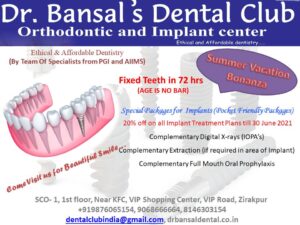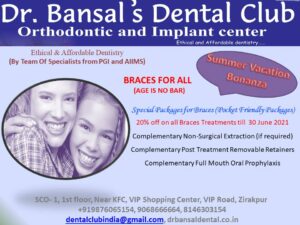FAQs Braces/Orthodontics
How do I know if my child is in need of orthodontic treatment?
It is usually difficult for you to determine if treatment is necessary because there are many problems that can occur even though the front teeth look straight. Conversely, there are some conditions which look intimidating and complex that will resolve on their own. Asking your general dentist is good reference and we are your best resource since orthodontics is our speciality. Our initial exam is complimentary and Dr. Ajay Bansal would be more than happy to see your child and make any recommendations necessary.
What are the early symptoms of orthodontic problems?
Although it is difficult for you to assess whether or not treatment is necessary, the following symptoms may help in prompting you to seek our orthodontic advice.
Look at your child’s teeth
- If you see any signs of crooked teeth, gaps between teeth or overlapping teeth, your child may need orthodontic treatment.
While keeping the lips open so you can see the teeth, ask your child to bite all the way down.
- Do the front top teeth line up with the bottom?
- Do the top teeth protrude out away from the bottom teeth?
- Do the top front teeth cover more than 50% of the bottom teeth?
- Are the top teeth behind the bottom teeth?
All these are indicators for potential orthodontic treatment.
Look at the alignment of your child’s jaw.
- Does the jaw shift off center when your child bites down?
If you see any misalignment or shifting of the jaw, your child may have a skeletal problem which requires early orthodontic intervention.
These are only some of the obvious symptoms of orthodontic problems.
What age should My Child be seen by an orthodontist?
The American Association of Orthodontists recommends that your child be evaluated by age 7 years. Early detection of some of Jaws growth related problems are important in order to take Early Corrective action and avoid more difficult treatment later. Corrective treatment with braces is usually carried out after 10 years of age. Some common signs that may be indicating factors that your child will need orthodontic treatment include:
- Early or late loss of primary teeth
- Habits like Thumb sucking, •Finger sucking
- Crowded or misplaced teeth
- Difficulty biting or chewing
- Clicking or popping jaws
- Biting the cheek
- Apparent abnormal bite
- Apparent facial imbalance
An early orthodontic evaluation allows your orthodontist to recognize potential problems early and correct them before they become more serious.
How does child’s growth affect orthodontic treatment?
Your child’s growth and orthodontic treatment can work well with each other. Often times either the upper front teeth are protruding ahead of the lower teeth because the lower jaw is shorter than the upper jaw or visa versa. During Growth phase (7-12 years), we can use myofunctional appliances to help guide their growth allowing the lower jaw to catch up with the upper jaw.
If growth modification is not done at this stage, corrective surgery may be necessary. It is important if your child has problems with the width or length of their jaws to be evaluated by age 10 for girls and 12 for boys.
Can you be too old for braces?
No. Age is not a factor, only the health of your gums and bone which support your teeth. With increasing awareness and affordability, about 30% of our orthodontic patients are adults and that number is still growing!
Do teeth need to be extracted in every case for braces?
Removing teeth is sometimes required, but not in all cases, to achieve the best/desirable However, because new technology has provided advanced orthodontic procedures, removing teeth is not always necessary for orthodontic treatment.
Will Braces hurt?
Orthodontic treatment has improved dramatically. Today’s braces are smaller and more comfortable than ever. As a rule, braces make your teeth sore for a few days, but it is not painful. This annoyance can be relieved with an over-the-counter pain reliever. We use the latest in combination of miniature braces, titanium and thermal titanium archwires, plus the highest quality of orthodontic materials in order to reduce discomfort and treatment time.
Will wearing braces interfere with playing musical instruments?
While it may take some time getting used to playing instruments, such as wind or bass instruments, typically braces do not interfere with playing instruments.
Can one-play sports during orthodontic treatment?
Yes, we recommend a mouth guard for all sports.
Can I still have braces if I have missing teeth?
Yes. When teeth are missing, adjacent teeth will drift into the empty space. This will cause a functional, aesthetic or periodontal problem. Orthodontic treatment will correct and prevent these problems from happening and will also provide proper alignment for your dentist to replace the missing teeth.
FAQs about Orthodontic Treatment
What is Phase I (Interceptive) treatment?
Phase I or interceptive treatment usually starts when children have most of their baby teeth and a few of their permanent front incisors. This stage in development usually occurs about the age of seven.
The goal of Phase I treatment is to intercept a moderate or severe orthodontic problem early in order to reduce or eliminate it. These problems include skeletal dysplasias, crossbites and crowding, Habits. Phase I treatment takes advantage of the early growth spurt and turns a difficult orthodontic problem into a more manageable one. This helps reduce the need for extractions or surgery and delivers better long term results and treatment options. Most Phase I patients require a Phase II treatment in order to achieve an ideal bite.
What is Phase II (Corrective) treatment?
The goal of Phase II treatment is to achieve an ideal occlusion with all of the permanent teeth. Phase II treatment on average occurs after 10-12 years of age when most of the permanent teeth erupts. Phase II treatment is a shortened and simplified stage of full braces.
What is full or comprehensive orthodontic treatment?
This is another name for Phase II Orthodontic treatment in the permanent dentition at any age. It is more commonly used when a Phase I treatment was not performed.
Does everyone need a Phase I treatment?
Absolutely not! Only certain growth related problems or cross bites etc require early intervention. All others can wait until most, if not all their permanent teeth erupt.
Can I wait on Phase I / interceptive orthodontic treatment until my child is older?
This is not recommended. If your child needs Phase I treatment this usually means that he has a difficult problem that requires attention now. If no action is taken at this stage, treatment options become limited, more difficult, and the long term stability may be compromised. In addition, it may lead to extractions, Jaw surgery and increased expense.
What is the length or duration of orthodontic treatment?
Braces may be worn from 6 to 30 months, or longer, depending on the age of the patient, the severity of the problem, patient’s cooperation, and the degree of movement possible.
What are extraction and non-extraction therapy, and what are the advantages and disadvantages of each?
Extraction therapy is a technique where some teeth are removed to make room for the other teeth in your child’s mouth. This is in contrast to non-extraction therapy which may include the use of appliances to encourage growth of the jaws and or reducing the width of some teeth to make all of the teeth fit. Early examination and interceptive first phase treatments when indicated can greatly reduce extraction therapy.
Other FAQs
What are the different types of braces?
There are – the Metal braces/ Clear Ceramic braces/24 karat gold plated metal braces/ Self Ligating Braces/ Clear Aligners etc.
Children and adolescents enjoy changing the appearance of their metal braces with colored ties at successive appointments. Color ties are available at no additional expense. Clear braces are popular with adults and the self-conscious individual. Gold braces are modern and stylish and are indicated with certain allergies to metal. As a parent or patient, you will have to decide which types of braces are best suited for you.
What are lingual braces?
Lingual braces are an interesting and intriguing approach to straightening teeth. These braces are mounted on the inside of a patient’s teeth. They were in parlance few years ago but are not commonly used today. Generally, lingual braces are more uncomfortable than standard braces and some patients have trouble speaking clearly. Orthodontic treatment may take longer and is more costly with lingual braces.
Should I pay extra for designer braces?
If your stress levels will drop, or you have greater self-confidence, or you look forward to visits in our office, then the answer is yes! In addition, the cost for these braces is a minor fraction of the cost of orthodontic treatment. Considering the time spent, orthodontics is regarded as dentistry’s best value.
Is orthodontic care expensive?
When orthodontic treatment is implemented at the proper time, treatment is often less costly than the dental care required to treat the more serious problems that can develop years later. Orthodontic fees have not increased as fast as many other consumer products. Financing is usually available and our office has payment programs that will meet your needs. In addition, many insurance plans now include orthodontics.
Do Retainers are needed in all cases after Orthodontics?
Yes, though time for the retainers varies depending upon the correction made
What is the purpose of retainers?
If not stabilized, the teeth can begin to shift out of position once the braces have been removed. Retainers are designed to hold teeth in the corrected position until the gums and bones are fully adapted to these changes. To ensure that your results last a lifetime, it is important to wear your retainers as instructed.
Will my child’s teeth shift back after discontinuation of Retainers?
As we age, our teeth tend to shift. Wearing retainers as instructed can help stabilize the correction and maintain your beautiful, straight smile for a lifetime. Once your orthodontist has instructed you that full time wear is no longer necessary, wearing your retainer nightly will help maintain the position of your teeth and prevent future shifting.
For More Information Contact Us. Alternatively you can Call us directly.


